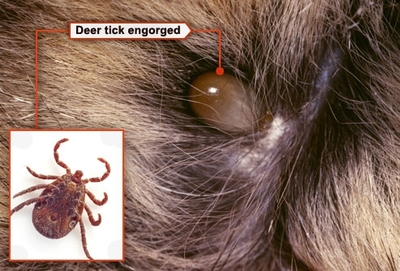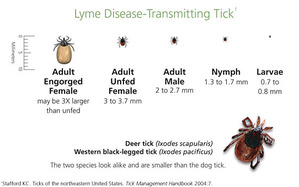Treating Lyme Disease in Dogs can be tricky. It helps to prevent bites, and start treatment early if an infection is discovered.
Lyme Disease is a bacterial infection passed on from ticks. While cases have been reported in humans and animals all over the country, they are most commonly seen in the Northeast, mid-Atlantic, and Northern central states.

Once a tick starts feeding, it becomes many times larger than it’s original size. The bacteria, borrelia burgdorferi, is a spirochete, meaning it is in the shape of a corkscrew. Having this shape, it can leave the bloodstream, and bore into organs, tissues, cross the blood brain barrier, and eventually damage the nervous system. Other co-infections such as erlichia.
Almost all cases of lymes are contracted from tick bites- a common occurrence for dogs living in or near the woods or in places with tall grass. Unfortunately the easiest indicator of an infection- a large bulls-eye rash on human skin- isn’t visible under fur, so catching the disease in its earliest stages can be difficult. If you live in a high-risk area and have seen your dog get ticks many times, it is very possible he or she is infected.

Some infected animals will live completely normal lives. Many dogs may not show immediate symptoms after an infection, but may become symptomatic months or even years later. The most common ones are fever, nausea, lack of appetite, fatigue, sensitivity to being touched, difficulty breathing, depression, and joint pain. Eventually, the continued inflammation may cause arthritis, heart or nervous system complications. Kidney failure may also occur in severe cases.
The two good bits of news is that there are products that keep dogs from getting bit, and a tick has to be attached for more than 18 hours to infect the host. If you live in a rural area that has a high risk for lymes transmission, there are once-a-month topical treatments that you can apply to your dog’s back that reduce the likelihood of getting bit to almost nil. There are also collars that help with preventing bites.
If you do find ticks on your dog (or yourself for that matter) the best way to remove them is to gently apply liquid soap around the tick until it releases and pulls itself out of the skin. Attempting to pull the tick off can not only hurt but can break the body off, leaving the head stuck in the skin. It this happens it can continue to tap into your dog’s bloodstream, potentially causing infection.
If an infection does occur, antibiotics can be highly effective if given in the first few weeks or even months after infection. Doxycycline is the most commonly prescribed antibiotic in use, amoxicillin or tetracycline are also used. Treatments generally run 4-6 weeks. Usually, infected animals will show improvements within a few days, and will make a full recovery during the course of the antibiotic treatment. If your dog has lymes from a bite that occurred many months or years ago, and the infection has become chronic antibiotics will be increasingly less effective. Even if treated immediately some animals relapse when antibiotic treatment is over and need to be treated as chronic cases.

In this situation, treatments may include alternative approaches such as acupuncture, herbs, or homeopathy. Herbalist Stephen Harrod Buehner has developed a protocol for humans that is also safe and effective for animals. You can check it out here http://planetthrive.com/2011/08/dogs-and-cats-with-lyme/ . Other herbs that may be safe for humans may not be safe for animals, so please find a holistic veterinarian if you are treating your dog for chronic lymes.
The Assisi Portable™ can be of help in helping dogs with chronic lymes or severe active infections deal with the joint pain and swelling caused by the infection. The “Loop,” has been clinically demonstrated to reduce inflammation, speed healing and help with joint pain. Many anecdotal cases also show myelopathies and nerve damage show improvement with long term use of the Assisi Portable™ which may be of benefit, especially to chronic sufferers.
